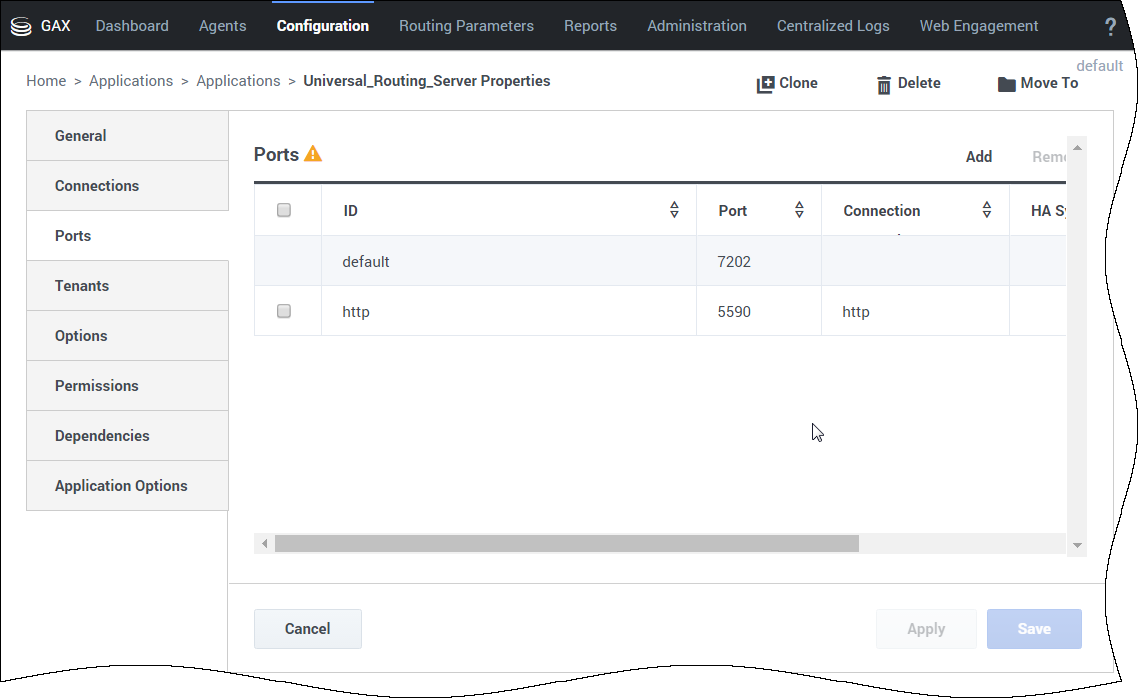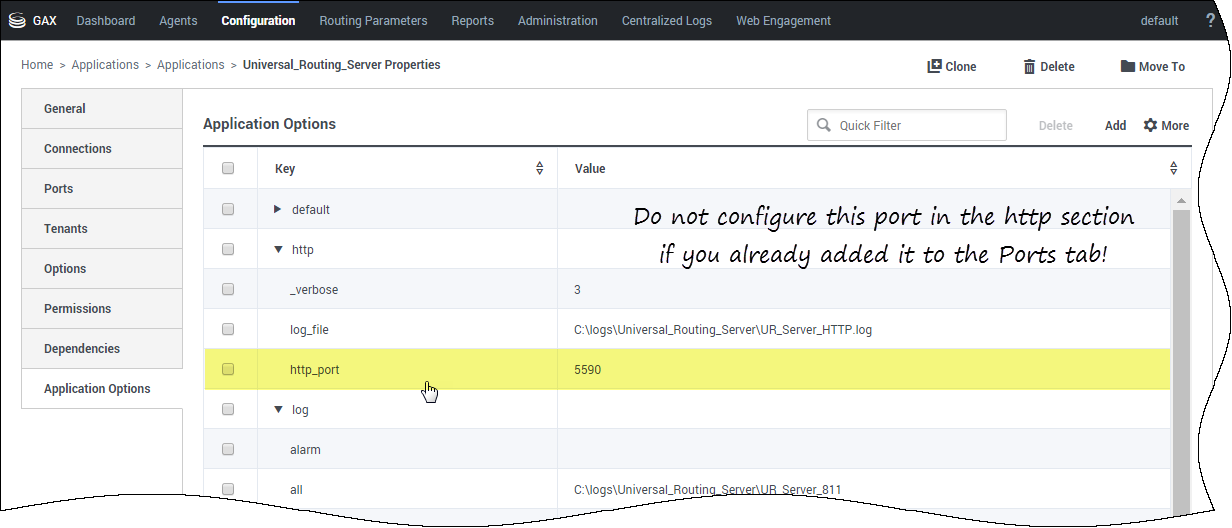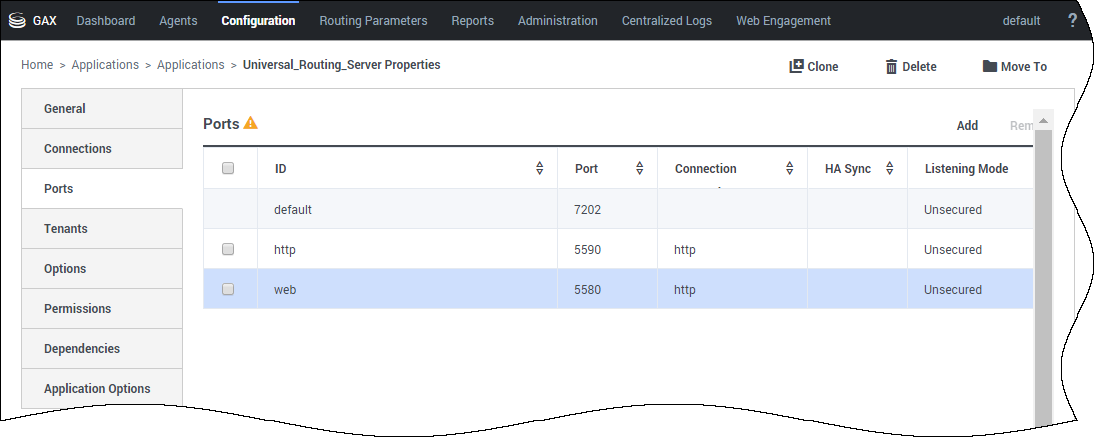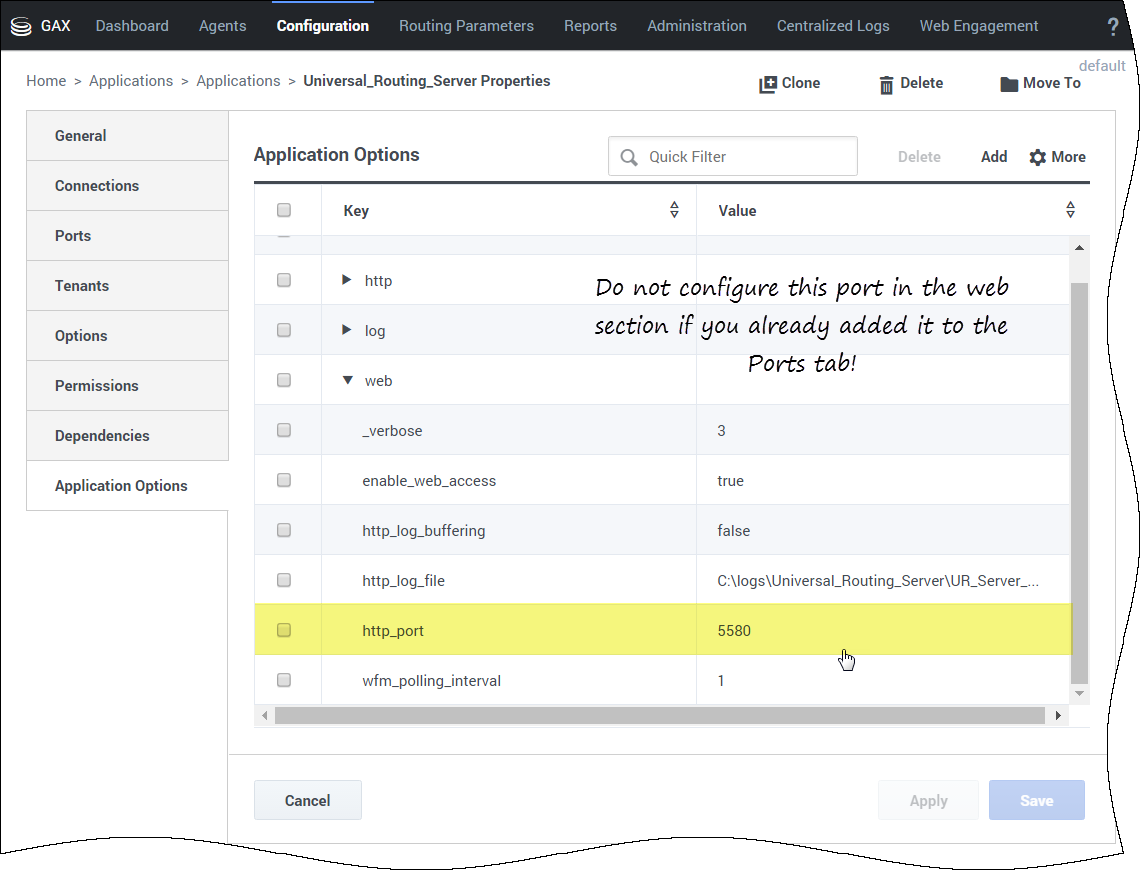Contents
Configuring Routing Dependencies
Before getting started with your GMS services, you must first ensure that external dependencies are configured properly. The following outline will guide you through each dependency.
Note: These procedures assume a multi-tenant configuration and Tenant = Environment.
Universal Routing Server
GMS requests URS to start strategies by HTTP, and GMS receives asynchronous Callbacks from URS by HTTP. To enable the HTTP interface:
Create a Listening HTTP Port in URS
URS will listen on this port for incoming HTTP requests. Basically, this steps turns URS into an HTTP server.
In Genesys Administrator Extension, edit your URS application.
Add an HTTP listening port with a port ID http in the Ports tab. Make a note of this port number as you will need it later when configuring GMS and ORS-based services.
You can also do this by creating the http_port option in the http section of your Application Options tab.
Enable Web HTTP Replies in URS
URS uses the httpbridge module to send target information back to GMS. To make this possible, create a web HTTP port that will be used to reply. URS will be able to perform external HTTP requests, for example, to submit timetodial events to GMS, and so on.
In Genesys Administrator Extension, edit your URS application. Add an HTTP port with a port ID web in the Ports tab.
You can also do this by creating the http_port option in the web section of your Application Options tab.
- http_port = 5580 (or some other port, used internally)
Configure Strategies
You must deploy URS delay strategies. This step is required because when a service request is received by GMS, the request is sent to ORS for execution. ORS then sends a request to URS to create a virtual interaction and to place it in the specified virtual queue. When an agent is available, URS sends an asynchronous response containing the selected target information to GMS, via a URL specified at the time of creation of the virtual interaction. For samples, you will create a new virtual queue in which to place the interactions, however, for a real-world scenario, the virtual queue must be selected appropriately.
Deploy URS Delay Strategies
- Go to Configuration Manager > Switching > DNs > Switches > SIP_Switch > DN > Virtual Queue.
- Create a virtual queue GMS_VQ with alias GMS_VQ_SIP_Switch.
- Download the URS Strategies and import them into IRD. See the procedure URS Strategy to access the downloadable files and for more details.
| GMS version | ZIP | Instructions |
|---|---|---|
| 8.5.004.xx and earlier | GMS_URS_Strategy.zip |
|
| between 8.5.005.xx and 8.5.101.10 | GMS_URS_Strategy_85005.zip | |
| between 8.5.101.10 and 8.5.107.19 | GMS_URS_Strategy_85010_v2.3.zip | |
| 8.5.108.02 and higher | GMS_URS_Strategy_85108_v2.4.zip | |
| 8.5.109.08 and higher | GMS_URS_Strategy_85109_v2.58.zip | |
| 8.5.114.09 and higher |
GMS_URS_Strategy_85114_v2.63.1.zip GMS_URS_Strategy_852000_v2.64.1.zip GMS_URS_Strategy_85200_v2.66.zip | |
| 8.5.2 and higher | See URS Strategies in 8.5.2 |
- Starting in 8.5.109.08, the URS Dial Success Rate is set to 85% when new callbacks are created to improve the callback performance.
- Starting in 2.64.1, the DialOutSuccessRate function of the WaitForTarget strategy is no longer invoked to allow the enhanced VCB algorithm within Universal Routing Server to work properly. If your application requires the legacy VCB algorithm to work, change the strategy to invoke the DialOutSuccessRate function as in earlier versions of the strategy.
Enable ORS to pull interactions
- Go to Configuration Manager > Applications > Universal Routing Server Application
- Set the option Strategy=ORS.
SIP Server
- Enable the answering machine connection, which is required for user-terminated scenarios with Call Progress Detection (CPD) capability. To do this:
- Go to Configuration Manager > Applications > SIP Server Application, and set TServer/am-detected = connect.
- Enable MSML, which is required so SIP Server can communicate with GVP as a Media Server to delegate outbound calls, play treatments, and CPD. To do this, set the following:
- TServer/msml-support=true
- TServer/refer-enabled=true
Web API Server
Media Server (GVP)
Note: See the Genesys Voice Platform Deployment Guide for additional details.
- GMS Callback uses Media Server via SIP Server:
- To play treatments.
- For CPD (Call Progress Detection).
- To make outbound calls.
- SIP Server talks to Media Server using MSML and requires the following configuration to enable:
- Go to Configuration Manager > SIP_Switch > DN > VOIP Service > MSML_Service.
- Make sure that the following options are configured for MSML_Service to enable outbound:
- make-call-rfc3725-flow=1
- refer-enabled=false
- ring-tone-on-make-call=false
- userdata-map-filter=*
- Configure the Routing Point for outbound source DN. To do this, go to Configuration Manager > Switches > SIP_Switch > DN > Routing Point.
- Create a Routing Point object with name 8999 and alias 8999_SIP_Switch.





